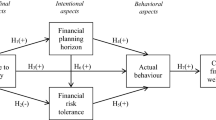Abstract
This paper examines the optimal asset allocation for defined-contribution pension plans in an inflationary economy under money illusion. The financial market consists of nominal bonds, inflation-linked bonds, and a stock index. The objective of the pension plan is to maximize the expected utility of a mixture of nominal and real wealth at retirement, as the plan member partially overlooks inflation and tends to think in terms of nominal rather than real monetary values. We obtain the optimal strategy and demonstrate the impacts of money illusion on asset allocation. In particular, money illusion significantly reduces investment in inflation-linked bonds. We also show that (even partially) overlooking inflation can lead to considerable welfare losses.





Similar content being viewed by others
Notes
Direct investment in real estate is not allowed in DC plans. Nevertheless, plan members can gain exposure to real estate through real estate investment trusts (REITs). Notably, many REITs are included in the S &P 500 index.
Employer-sponsored retirement plans are classified into two types: defined-benefit (DB) plans and defined-contribution (DC) plans. The investment strategy of DB plans is made by professional fund managers. However, for DC plans such as 401(k), plan members take on the investment risk and choose their own investment strategies (Baranoffet al. 2021) and hence are more likely to suffer from money illusion.
For tractability, we assume the labor income and the contribution (in real terms) are deterministic. The main results of our paper remain valid if we allow the contribution rate to be stochastic but spanned by the assets in the market, which is a standard assumption in the existing literature to obtain explicit solutions. In this case, the uncertainty in the contribution rate can be perfectly hedged by appropriate positions in the tradable assets. This will affect the hedging portfolio \(h_t\) in Lemma 3.1 but not the optimal control \(\alpha _t\) in Theorem 3.1. Therefore, all our numerical results will be unchanged.
References
Baltas I, Dopierala L, Kolodziejczyk K, Szczepański M, Weber G-W, Yannacopoulos AN (2022) Optimal management of defined contribution pension funds under the effect of inflation, mortality and uncertainty. Eur J Oper Res 298(3):1162–1174
Baranoff E, Brockett P, Kahane Y, Baranoff D (2021) Risk management for individuals and enterprises. FlatWorld
Basak S, Yan H (2010) Equilibrium asset prices and investor behaviour in the presence of money illusion. Rev Econ Stud 77(3):914–936
Battocchio P, Menoncin F (2004) Optimal pension management in a stochastic framework. Insur Math Econ 34(1):79–95
Bensoussan A (2004) Stochastic control of partially observable systems. Cambridge University Press
Boulier J-F, Huang S, Taillard G (2001) Optimal management under stochastic interest rates: the case of a protected defined contribution pension fund. Insur Math Econ 28(2):173–189
Brennan MJ, Xia Y (2002) Dynamic asset allocation under inflation. J Financ 57(3):1201–1238
Browne S (1999) Beating a moving target: optimal portfolio strategies for outperforming a stochastic benchmark. Financ Stoch 3(3):275–294
Brunnermeier MK, Julliard C (2008) Money illusion and housing frenzies. Rev Financ Stud 21(1):135–180
Cairns AJ, Blake D, Dowd K (2006) Stochastic lifestyling: optimal dynamic asset allocation for defined contribution pension plans. J Econ Dyn Control 30(5):843–877
Chen CR, Lung PP, Wang FA (2009) Stock market mispricing: money illusion or resale option? J Financ Quant Anal 44(5):1125–1147
Chen CR, Lung PP, Wang FA (2013) Where are the sources of stock market mispricing and excess volatility? Rev Quant Financ Account 41(4):631–650
Cocco JF, Gomes FJ, Maenhout PJ (2005) Consumption and portfolio choice over the life cycle. Rev Financ Stud 18(2):491–533
David A, Veronesi P (2013) What ties return volatilities to price valuations and fundamentals? J Polit Econ 121(4):682–746
Deelstra G, Grasselli M, Koehl P-F (2003) Optimal investment strategies in the presence of a minimum guarantee. Insur Math Econ 33(1):189–207
Deelstra G, Grasselli M, Koehl P-F (2004) Optimal design of the guarantee for defined contribution funds. J Econ Dyn Control 28(11):2239–2260
Duffie D, Kan R (1996) A yield-factor model of interest rates. Math Financ 6(4):379–406
Eisenhuth R (2017) Money illusion and market survival. Macroecon Dyn 21(1):1–10
Fehr E, Tyran J-R (2001) Does money illusion matter? Am Econ Rev 91(5):1239–1262
Fehr E, Tyran J-R (2007) Money illusion and coordination failure. Games Econ Behav 58(2):246–268
Fisher I (1928) The money illusion. Adelphi Co
Fleming WH, Soner HM (2006) Controlled Markov processes and viscosity solutions. Springer Science and Business Media, Berlin
Forsyth PA, Vetzal KR, Westmacott G (2020) Optimal asset allocation for dc pension decumulation with a variable spending rule. ASTIN Bull 50(2):419–447
Gerrard R, Haberman S, Vigna E (2004) Optimal investment choices post-retirement in a defined contribution pension scheme. Insur Math Econ 35(2):321–342
Guan G, Liang Z (2014) Optimal management of DC pension plan in a stochastic interest rate and stochastic volatility framework. Insur Math Econ 57:58–66
Guan G, Liang Z (2016) Optimal management of DC pension plan under loss aversion and Value-at-Risk constraints. Insur Math Econ 69:224–237
Han N-w, Hung M-w (2012) Optimal asset allocation for DC pension plans under inflation. Insur Math Econ 51(1):172–181
He L, Liang Z, Liu Y, Ma M (2019) Optimal control of dc pension plan management under two incentive schemes. North Am Actuar J 23(1):120–141
Honda T, Kamimura S (2011) On the verification theorem of dynamic portfolio-consumption problems with stochastic market price of risk. Asia-Pac Financ Mark 18(2):151–166
Koijen RS, Nijman TE, Werker BJ (2011) Optimal annuity risk management. Rev Financ 15(4):799–833
Lioui A, Tarelli A (2023) Money illusion and tips demand. J Money Credit Bank 55(1):171–214
Ma Q-P (2011) On “optimal pension management in a stochastic framework’’ with exponential utility. Insur Math Econ 49(1):61–69
Menoncin F, Vigna E (2017) Mean-variance target-based optimisation for defined contribution pension schemes in a stochastic framework. Insur Math Econ 76:172–184
Miao J, Xie D (2013) Economic growth under money illusion. J Econ Dyn Control 37(1):84–103
Modigliani F, Cohn RA (1979) Inflation, rational valuation and the market. Financ Anal J 35(2):24–44
Munk C, Sørensen C (2010) Dynamic asset allocation with stochastic income and interest rates. J Financ Econ 96(3):433–462
Shafir E, Diamond P, Tversky A (1997) Money illusion. Q J Econ 112(2):341–374
Svedsäter H, Gamble A, Gärling T (2007) Money illusion in intuitive financial judgments: influences of nominal representation of share prices. J Socio-Econ 36(5):698–712
Tan KS, Wei P, Wei W, Zhuang SC (2020) Optimal dynamic reinsurance policies under a generalized Denneberg’s absolute deviation principle. Eur J Oper Res 282(1):345–362
Tang M-L, Chen S-N, Lai GC, Wu T-P (2018) Asset allocation for a DC pension fund under stochastic interest rates and inflation-protected guarantee. Insur Math Econ 78:87–104
Vahabi S, Najafabadi ATP (2022) Optimal investment strategy for a dc pension fund plan in a finite horizon time: an optimal stochastic control approach. Ann Actuar Sci 16(2):367–383
Wang P, Shen Y, Zhang L, Kang Y (2021) Equilibrium investment strategy for a dc pension plan with learning about stock return predictability. Insur Math Econ 100:384–407
Wonham WM (1968) On a matrix Riccati equation of stochastic control. SIAM J Control 6(4):681–697
Xu M, Sherris M, Shao AW (2020) Portfolio insurance strategies for a target annuitization fund. ASTIN Bull 50(3):873–912
Xue X, Wei P, Weng C (2019) Derivatives trading for insurers. Insur Math Econ 84:40–53
Yao H, Yang Z, Chen P (2013) Markowitz’s mean-variance defined contribution pension fund management under inflation: a continuous-time model. Insur Math Econ 53(3):851–863
Zeng Y, Li D, Chen Z, Yang Z (2018) Ambiguity aversion and optimal derivative-based pension investment with stochastic income and volatility. J Econ Dyn Control 88:70–103
Funding
No funding was received for conducting this study. The authors have no relevant financial or non-financial interests to disclose. All authors certify that they have no affiliations with or involvement in any organization or entity with any financial interest or non-financial interest in the subject matter or materials discussed in this manuscript. The authors have no financial or proprietary interests in any material discussed in this article.
Author information
Authors and Affiliations
Corresponding author
Ethics declarations
Conflict of interest
The authors have no competing interests to declare that are relevant to the content of this article.
Additional information
Publisher's Note
Springer Nature remains neutral with regard to jurisdictional claims in published maps and institutional affiliations.
Rights and permissions
Springer Nature or its licensor (e.g. a society or other partner) holds exclusive rights to this article under a publishing agreement with the author(s) or other rightsholder(s); author self-archiving of the accepted manuscript version of this article is solely governed by the terms of such publishing agreement and applicable law.
About this article
Cite this article
Wei, P., Yang, C. Optimal investment for defined-contribution pension plans under money illusion. Rev Quant Finan Acc 61, 729–753 (2023). https://doi.org/10.1007/s11156-023-01169-w
Accepted:
Published:
Issue Date:
DOI: https://doi.org/10.1007/s11156-023-01169-w




